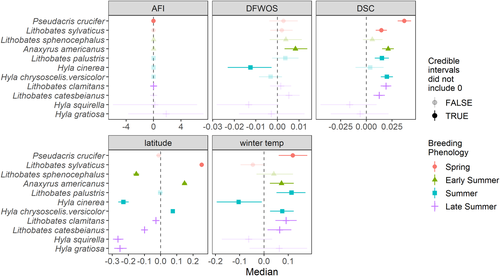Winter severity affects occupancy of spring- and summer-breeding anurans across the eastern United States
Abstract/Summary
Climate change is an increasingly important driver of biodiversity loss. The ectothermic nature of amphibians may make them particularly sensitive to changes in normal temperature and precipitation regimes, exacerbating global declines from other threats. In this study, we used large-scale citizen science data from the eastern half of the United States to assess how variation in winter severity influenced occupancy dynamics of 11 anuran species. We found that most species had increased occupancy in years with greater than average snow cover and warmer than average mean winter temperatures. Surprisingly, we found that climatic conditions in winter affected occupancy dynamics of both spring and summer breeding species, indicating that changing winter conditions may have consequences for anuran species with varying life history characteristics. As the climate continues to change, expected reductions in snowpack may act as an additional stressor on already declining anuran populations, while milder winters may improve overwinter survival for some species.
Publication details
| Published Date: | 2022-08-09 |
| Outlet/Publisher: | Diversity and Distributions |
| Media Format: |
ARMI Organizational Units:
Northeast - BiologyTopics:
DroughtMonitoring and Population Ecology
Place Names:
Northeast U.S.Southeast U.S.
Keywords:
amphibianscall surveys
climate change
occupancy

